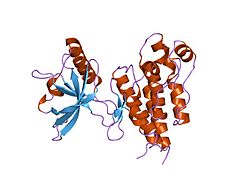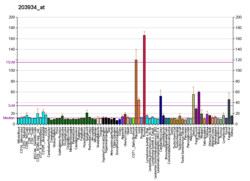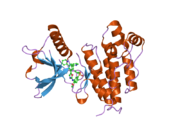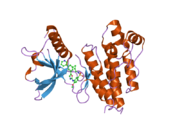Kinase insert domain receptor
Kinase insert domain receptor (KDR, a type III receptor tyrosine kinase) also known as vascular endothelial growth factor receptor 2 (VEGFR-2) is a VEGF receptor. KDR is the human gene encoding it. KDR has also been designated as CD309 (cluster of differentiation 309). KDR is also known as Flk1 (Fetal Liver Kinase 1).
Interactions
Kinase insert domain receptor has been shown to interact with SHC2,[5] Annexin A5[6] and SHC1.[7][8]
See also
Further reading
References
- ^ a b c GRCh38: Ensembl release 89: ENSG00000128052 – Ensembl, May 2017
- ^ a b c GRCm38: Ensembl release 89: ENSMUSG00000062960 – Ensembl, May 2017
- ^ "Human PubMed Reference:". National Center for Biotechnology Information, U.S. National Library of Medicine.
- ^ "Mouse PubMed Reference:". National Center for Biotechnology Information, U.S. National Library of Medicine.
- ^ Warner, A J; Lopez-Dee J; Knight E L; Feramisco J R; Prigent S A (April 2000). "The Shc-related adaptor protein, Sck, forms a complex with the vascular-endothelial-growth-factor receptor KDR in transfected cells". Biochem. J. 347 (Pt 2). England: 501–9. doi:10.1042/0264-6021:3470501. ISSN 0264-6021. PMC 1220983. PMID 10749680.
{{cite journal}}: Cite has empty unknown parameters:|laydate=,|laysource=, and|laysummary=(help) - ^ Wen, Y; Edelman J L; Kang T; Sachs G (May 1999). "Lipocortin V may function as a signaling protein for vascular endothelial growth factor receptor-2/Flk-1". Biochem. Biophys. Res. Commun. 258 (3). UNITED STATES: 713–21. doi:10.1006/bbrc.1999.0678. ISSN 0006-291X. PMID 10329451.
{{cite journal}}: Cite has empty unknown parameters:|laydate=,|laysource=, and|laysummary=(help) - ^ Zanetti, Adriana; Lampugnani Maria Grazia; Balconi Giovanna; Breviario Ferruccio; Corada Monica; Lanfrancone Luisa; Dejana Elisabetta (April 2002). "Vascular endothelial growth factor induces SHC association with vascular endothelial cadherin: a potential feedback mechanism to control vascular endothelial growth factor receptor-2 signaling". Arterioscler. Thromb. Vasc. Biol. 22 (4). United States: 617–22. doi:10.1161/01.ATV.0000012268.84961.AD. PMID 11950700.
{{cite journal}}: Cite has empty unknown parameters:|laydate=,|laysource=, and|laysummary=(help) - ^ D'Angelo, G; Martini J F; Iiri T; Fantl W J; Martial J; Weiner R I (May 1999). "16K human prolactin inhibits vascular endothelial growth factor-induced activation of Ras in capillary endothelial cells". Mol. Endocrinol. 13 (5). UNITED STATES: 692–704. doi:10.1210/mend.13.5.0280. ISSN 0888-8809. PMID 10319320.
{{cite journal}}: Cite has empty unknown parameters:|laydate=,|laysource=, and|laysummary=(help)
External links
- Kinase+insert+domain+receptor at the U.S. National Library of Medicine Medical Subject Headings (MeSH)
This article incorporates text from the United States National Library of Medicine, which is in the public domain.








